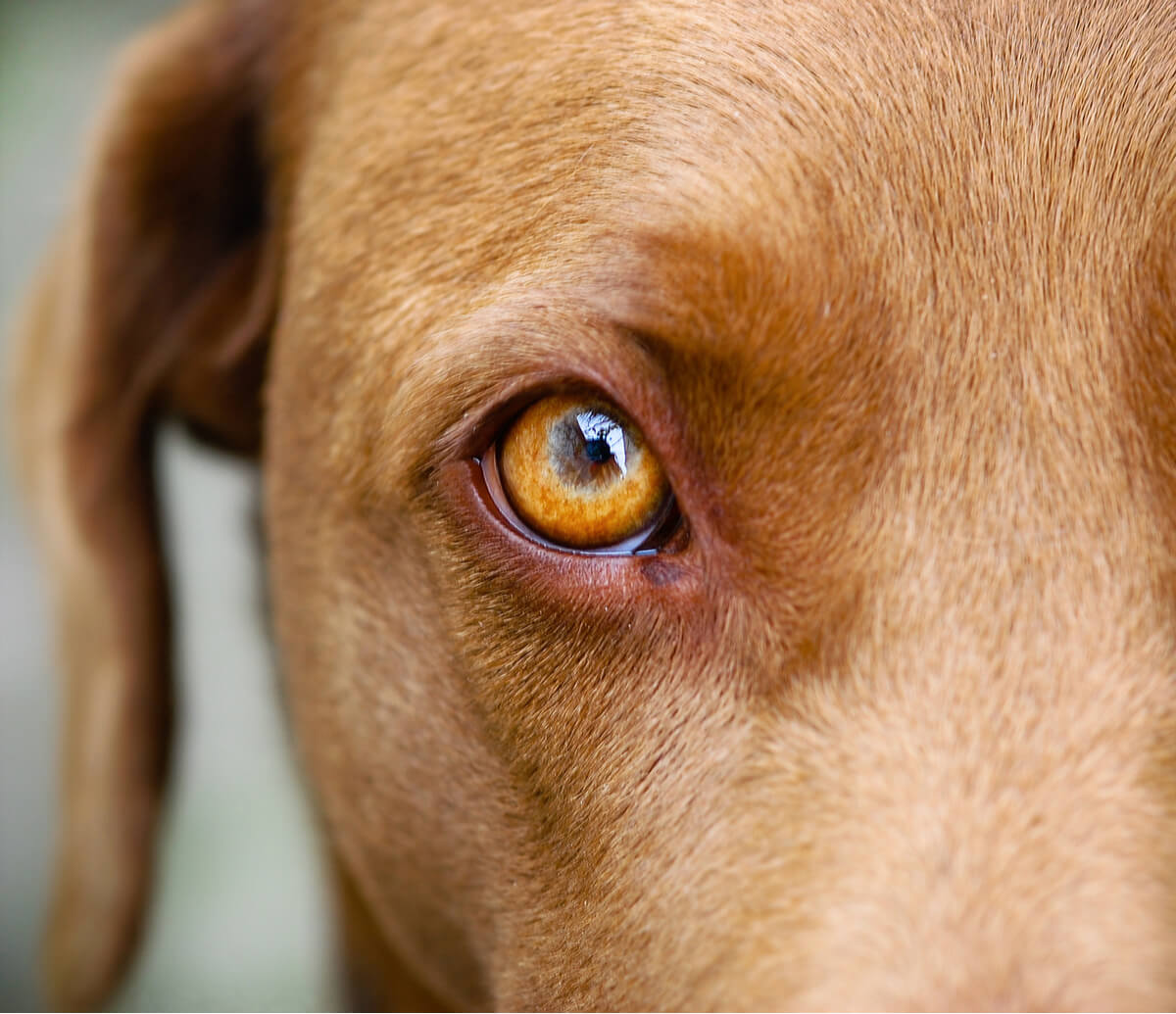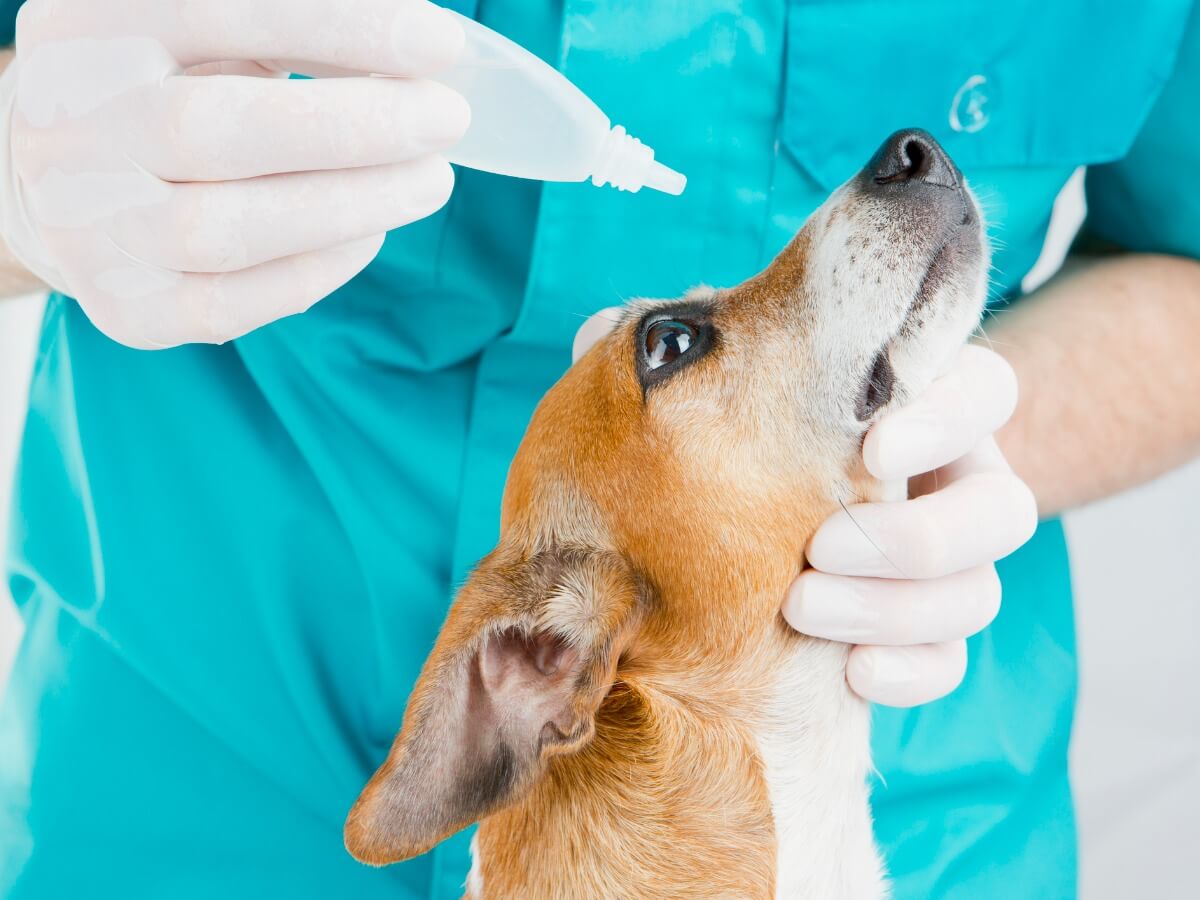Uveitis in Dogs: Causes, Symptoms and Treatment


Written and verified by the biologist Samuel Sanchez
Uveitis in dogs is the most common cause of visits to the vet for ophthalmic conditions and one of the main triggers of canine blindness. Despite how common this condition is, many times clear etiological agents are not found and the approach can be complicated.
The cause of uveitis is conditioned by where the dog lives, the trips it has made in its life, the environment, age, gender and race, among other things. This condition can have many causes and sometimes appears as a synergistic medical sign on several different fronts. If you want to find out more about it, keep reading.
What is canine uveitis?
The term uveitis refers – in its strictest sense – to inflammation of the uvea. However, before diving into the condition, we’ll need to briefly explore a dog’s ocular physiology.
The dog’s eye is made up of 3 chambers, all of which can be affected by uveitis. The anterior chamber is the space between the cornea and the iris, that is, under the circular structure that gives the eye its color and that controls the size of the pupil. On the other hand, the rear chamber refers to the space between the iris and the lenses.
For its part, the uvea is the vascular component of the eye and includes the iris, the ciliated body – part of the ocular wall that produces fluids – and the choroid, the layer of blood vessels and tissue between the white part of the eye and the retina. Thus, uveitis is the condition that affects one or more parts of this structure. According to this rule, we can differentiate different types:
- Anterior: The inflammation is localized in the area of the iris.
- Intermediate: This includes ciliated body affectations.
- Posterior: This refers to the inflammation of the choroid.
- Panuveitis: This affects all the abovementioned structures at the same time.
On the other hand, it should be noted that an eye inflammation can be due to a natural process (infection) or an allergy. Be that as it may, the deposition of immune complexes in the eye causes the eye to become inflamed and necrotic over time. Most intraocular damage comes from the immune system itself, not from the pathogen.

Causes of uveitis in dogs
A study published in the scientific portal ResearchGate explored the causes of uveitis in 102 dogs between 1989 and 2000. Of all the patients, 58% were diagnosed with idiopathic uveitis —with no known cause—, 24.5% with neoplasms and 17.6% with bacterial infections. This indicates that microscopic agents are certainly not always the triggers.
Uveitis in dogs can be divided according to several parameters. Next up, we’ll bring you the classification criteria followed by professional veterinary clinics.
Exogenous uveitis
In this, the causes of inflammation are “external” to the eye. This category includes direct blows to the ocular environment and corneal ulcerations, for example.
Endogenous uveitis
This category encompasses all conditions that occur from within the eye. The pathology may have developed within the ocular environment or, in contrast, originate in another part of the body and affect the eye in one way or another. Let’s see some of the causes of endogenous uveitis:
- Viruses: Among the main suspects are canine adenovirus, rabies and distemper.
- Bacteria: The main bacterial infections that cause uveitis in dogs are those caused by the genera Leptospira, Borrelia, Brucella, Mycobacterium, and Bordetella.
- Parasites: Some morphologically complex parasites, such as heartworms and other roundworm nematodes, can cause this condition. In these conditions, the “worms” end up in the ocular environment, usually by mistake.
- Metabolic diseases: Septicemia, hypertension or diabetes.
- Neoplasms: Primary tumors may appear in the eye or derive from a metastasis.
- Autoimmune diseases: The canine’s immune system can interpret the uvea or some of its products as foreign bodies. In this case, lymphocytes and other cell bodies mistakenly attack the eye.
On the other hand, it should also be noted that a significant percentage of the conditions are idiopathic in nature. This means that there’s no specific cause to explain why the uvea has become inflamed.
Symptoms of uveitis in dogs
The first sign that a dog has uveitis is that one or both eyes become visibly red and swollen.. The affected eye tends to remain closed and the dog may avoid light sources directly (photophobia). It’s also common to notice an “opaque” or “cloudy” ocular area, a clinical sign that shows corneal damage.
Taking a closer look at the animal’s eye will show that the pupil is constricted and the iris will be slightly higher than normal. Also, the ocular environment can bleed, produce pus, or excess tear fluid. Any of these symptoms warrant an urgent visit to the vet.
Veterinary diagnosis
At the veterinary clinic, the professional will suspect uveitis after a simple physical examination. However, the condition looks a lot like glaucoma, and so certain diagnostic tests are necessary. First, the intraocular pressure (IOP) of the affected eye must be measured: if it’s less than 5 mm Hg, glaucoma is ruled out.
Sometimes corneal opacity can make diagnosis very difficult, so ultrasound techniques may need to be used to examine the inside of the eye. Blood tests are also often performed and samples are collected from the ocular environment, in order to find the exact cause of the disease.
Even so, it’s sometimes impossible to find clear causal agents.
Treatment
The goal of uveitis treatment is divided into 3 distinct branches: alleviating the effects of inflammation in the ocular area, finding the causative agent, and eliminating any factor that’s causing the damage. Corticosteroids are the drugs that are always used in the first instance, as they inhibit vasodilation and the vascular permeability of the eye. With this, they reduce inflammation.
These drugs must be applied topically on a daily basis, and are usually sold in the form of eye drops. In the initial phases, 4 to 6 daily dosages are used, which will be reduced once the dog’s eye begins to improve. Prednisolone acetate (1%) and dexamethasone alcohol (0.1%) are the most used for their ocular penetration.
If the cause is exogenous (trauma), repair surgery and removal of any foreign bodies are usually necessary. If the trigger is endogenous and it’s an infection, then antifungals, antibiotics, or anthelmintics will be prescribed for each case.
Nonsteroidal anti-inflammatory drugs are sometimes prescribed along with corticosteroids.

Forecast
If treated properly, the symptoms of uveitis in dogs should begin to subside within 24 hours. However, if the canid has experienced bleeding, corneal damage, or purulent discharge, it may take a little longer to heal.
On the other hand, if uveitis is recurrent and isn’t addressed, then irreversible damage to the ocular area can occur, leading to total or partial blindness. In this pathology, every second counts to prevent a loss of the functionality of the eye.
All cited sources were thoroughly reviewed by our team to ensure their quality, reliability, currency, and validity. The bibliography of this article was considered reliable and of academic or scientific accuracy.
- Uveitis in dogs, Parry Medical Writing. Recogido a 24 de junio en http://www.parrymedicalwriting.com/wp-content/uploads/2011/09/24-canine-uveitis.pdf
- Uveitis in dogs, VCA Hospitals. Recogido a 24 de junio en https://vcahospitals.com/know-your-pet/uveitis-in-dogs
- Canine uveitis, Todays Veterinary Nurse. Recogido a 24 de junio en https://todaysveterinarynurse.com/articles/canine-uveitis-and-the-veterinary-technician/
- Massa, K. L., Gilger, B. C., Miller, T. L., & Davidson, M. G. (2002). Causes of uveitis in dogs: 102 cases (1989–2000). Veterinary ophthalmology, 5(2), 93-98.
- Townsend, W. M. (2008). Canine and feline uveitis. Veterinary Clinics of North America: Small Animal Practice, 38(2), 323-346.
This text is provided for informational purposes only and does not replace consultation with a professional. If in doubt, consult your specialist.